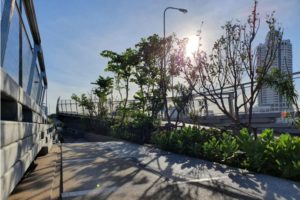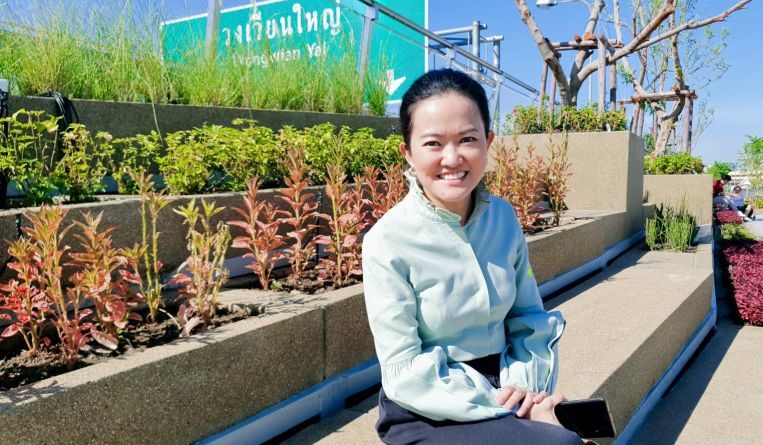TECH-AR: Sunlight, fresh air and self-contained neighbourhoods: Covid-19 will change urban design, say architects
Kotchakorn Voraakhom, landscape architect behind the new linear skypark across the Chao Phraya river. ST PHOTO: TAN HUI YEE/ Tan Hui Yee- Indochina Bureau Chief.
.


BANGKOK – A new linear park across the Chao Phraya River will open in Bangkok later this month. Built on an abandoned rail structure, it is perhaps a fitting icon of how urban landscapes can be adapted for life in the Covid-19 era.
The pandemic triggered lockdowns that shuttered economic life but also spurred new thinking about urban design in South-east Asia. Access to sunlight, fresh air and greenery – elements often sacrificed in the race to pack more people and activity into precious real estate – will gain currency, say regional architects interviewed by The Straits Times.
People will gravitate towards self-contained neighbourhoods and seek to reconnect with nature to make up for the isolation brought on by remote working and e-commerce, they say.


.

A section of the new linear skypark across the Chao Phraya River in Bangkok. ST PHOTO: TAN HUI YEE
.
Thai landscape architect Kotchakorn Voraakhom, whose firm helped create the new Bangkok skypark, says public spaces will need a rethink as societies adjust to new physical distancing needs.
“It’s not just about trying to add more public green space, but also to think about the ‘wasted’ space that we actually have in the city, and what can be done to it so that we can focus more on public health,” she said during a recent preview of the skypark.
Spanning 280m, the new facility connects two parks on the river banks of inner Bangkok. It features sheltered nooks, terraced lookout points over the water, as well as local plants specially selected for their hardy qualities.


Ms Kotchakorn, who created Asia’s largest urban rooftop farm in Thailand’s Thammasat University, says even existing parks created largely for aesthetic reasons should be adapted for current needs, and perhaps have their choice of plants reviewed to promote biodiversity.
Ms Ni Nyoman Dessy Anggadewi, an Indonesia-based architect from Singapore firm Goy Architects, expects more interest in self-contained developments that will allow residents to walk or cycle to work, or run their errands.
“We will still have big malls… but I think there will be growth of smaller-scale working spaces, or small pockets of green space around the city,” she said. “The urban fabric may change from these big patterns into smaller ‘dots’ around the city.”
Similarly, Phnom Penh-based Hun Chansan from Re-edge Architecture and Design thinks these self-sustainable neighbourhoods are the way to go.


“On an urban scale, cities need more green parks. On a neighbourhood scale, people need pockets of green spaces,” he said. “And on a building scale, people need outdoor spaces that are adjacent to what’s indoors, to allow fresh air to flow through buildings.”




Adjustments can be made even in densely built-up environments, architects say.
“During the lockdown… we had no choice but to live slowly. We realised that waking up to sunshine and the sound of nature is much better than waking to an alarm in a dark room,” said Ms Tran Thi Ngu Ngon from Vietnamese firm Tropical Space.
Future social distancing or quarantine needs, she said, can be met by introducing green walls in buffer zones like backyards of each building.
“We can surround a block or group of buildings with netting of plants, which can be opened or closed,” she said. “In some cases we may have to sacrifice some living area for the green buffer zone.” But the city as a whole will become more beautiful, she said.
Future building designs will likely incorporate more hands-free technology and seating layouts where co-workers do not face one another. Yet overly sterile environments could also stir a yearning for connection, say architects.



“The drawback of digitalisation is the possibility of increased cabin fever, where people don’t feel connected and people feel even more isolated,” said Goy Architects’ principal architect, Ms Goy Zhenru. People might start to lean more towards building materials with natural properties as they put them at ease, she said.
“People will start to say no, I want to feel well in the space, that wellness is more important,” she said. “If I stay in a sterile box, I can live for a hundred years, but I don’t see the point.”




SIGN UP TO RECEIVE OUR EMAIL
.
The most important news of the day about the ASEAN Countries and the world in one email: [email protected]
6.20.2020









